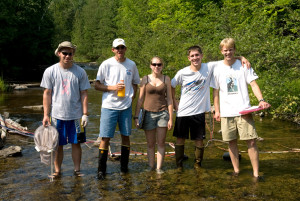Lamprey research at Hammond Bay leads to pheromone registration
by Peter Jakey–Managing Editor
It’s the first time a pheromone has been registered by the U.S. Environmental Protection Agency (EPA) to control a fish or vertebrate.
Researchers used a concept known to those in the agricultural industry for many years to continue the fight to reduce the number of sea lampreys in the Great Lakes.
Scientists used a lamprey’s basic instincts for mating against itself. The scents from the male lampreys attract the females into traps.

Most of the research resulting in the registration of this sea lamprey pheromone occurred at the Hammond Bay Biological Station (HBBS) and in the surrounding streams like the Trout River, Ocqueoc River and Silver Creek.
“At the station here, we were able to isolate and collect a lot of the pheromone so that Michigan State (University) researchers could identify it,” said Nick Johnson, HBBS research ecologist.
Since the 1990s, scientists have been researching the use of pheromones – natural odors used by sea lampreys to communicate – to manipulate sea lamprey behavior.
“Within the last five years, we started branching out from local rivers to the entire Great Lakes, including Ontario, doing additional trials to ramp up to this registration,” said Johnson. “Now that it has registered and passed all the tests EPA requires, it is now considered safe. Plus, we have an effective approach for using it.” It was registered in the U.S. and Canada at the same time after being reviewed for two years.
Research and development of the mating pheromone was funded by the Great Lakes Fishery Commission (GLFC) , with additional support from the Great Lakes Restoration Initiative, in collaboration with federal government, university, and private industry partners.
In the fall, the GLFC announced that sea lampreys had been knocked down to a 30-year low in Lake Huron.
The sea lampreys invasion is one of the worst human-caused ecological disasters ever inflicted upon the Great Lakes. Sea lampreys invaded through shipping canals and, by 1939, were present throughout the system. They attach to Great Lakes fish with a tooth-filled, suction cup mouth and file a hole through the fish’s scales and skin with a razor-sharp tongue. The average sea lamprey will kill up to 40 pounds (18 kg) of fish during its parasitic stage.
“The Great Lakes Fishery Commission is very excited about this accomplishment,” said Dr. Robert Hecky, chair of the commission.
Dr. Hecky emphasized the critical role of partners. “This achievement has been many years in the making and could not have occurred without the excellent work of our collaborators at the U.S. Geological Survey (USGS), Michigan State University, and Bridge Organics Company.”
On the local front, Johnson credits the assistance of the Department of Natural Resources for its permits to work on state land, as well as permits from the Presque Isle County Road Commission.
Over the years, a number of property owners have allowed researchers access to their land including, Dolly Trump, Lydia Lorenz (deceased), Andy Meyers, Paul Spens, Gene Brege, Lilla Freel, John Roper and other private land owners. Several businesses have provided housing for visiting researchers.
Many local residents have helped conduct the research including, Zak Smillie, Hayley O’Meara, Trevor O’Meara, Kyle Hill, Nicole Griewahn, David Partyka, Aaron Smuda, Henry Thompson, Linnea Brege, Melissa Pomranke, Amanda Pomranke, Joe Bednark, Margo Nowak, Ed Benzer, Tyler Buchinger, Brooklyn Idalski, Scott Couture, Staci Zalewski, and others.
“The work was driven by the support we receive
Dr. Suzette Kimball, USGS director, praised registration of the sea lamprey mating pheromone as “a milestone for control of invasive species and protection of natural biodiversity.
“Development of the sea lamprey mating pheromone is exactly the type of cutting-edge research that places each partner at the forefront of science.”
Since invading the Great Lakes in the 1800s and early 1900s, sea lampreys – parasitic, jawless vertebrates that feed on the blood and body fluids of other fish – have caused enormous ecological and economic damage.
To combat this menace, the commission coordinates an integrated sea lamprey control program implemented by the U.S. Fish and Wildlife Service (U.S. FWS) and Fisheries and Oceans Canada that combines lampricides, barriers, and traps. The control program is remarkably successful: sea lamprey populations in most areas of the Great Lakes have been reduced by 90 percent of the historical highs.
